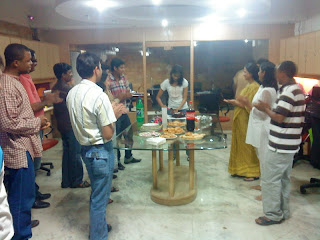As you have already found out, I haven’t been blogging lately because of the travel and development work I have been doing for HISP India. One of the new developments that I have been working over the last 3 months is a mobile phone application for routine health data collection, obscurely called “Mobile-SCDRT”. Its a Java ME MIDP that runs on all those commodity mobile phones and is used by a community health Sub-Center for Data Reporting and Transmission (SCDRT). Now you know where that obscure acronym came from and I am unsure who gave it that “wanna-be” name.
That apart, the mobile application is being deployed part of a pilot in the 5 states of Himachal Pradesh, Kerala, Rajasthan, Nagaland and Gujarat. As part of the pilot 200 health workers from the above states receive a Nokia 3110c mobile phone with the application installed and use the application to report the routine health-related data that is collected by the Government of India as part of Health Management Information System (HMIS).
The following is an architectural overview of how the application works for those of you interested in the technical details:

So, DHIS2 is where the data gets added after being sent from the mobile phone and in DHIS2 you can do all the analysis and “use of data” for health program decisions. There are other nitty-gritty details of the application and lots of new learnings for me, but I’ll leave that to another blog entry for another day.
We have started the pilot in 2 states: Himachal Pradesh and Kerala. Its been running for close to a month now in these 2 states and from the looks of it, people are happy and excited to use it. Recalling an incident from the launch in Kerala:- When just about 15 minutes of looking into the application, a JPHN (Junior Public Health Nurse - as health workers are called in Kerala) could explain the whole application, its use and reporting procedure to her colleagues better than most of us could. It was a wonderful and humbling experience for us to see that people were so much wanting to use the application and learnt it so quickly. It was satisfying to see that it was helping the health worker to make her reporting process more efficient. What was more rewarding for her, as I understand now, was the job perk that she thought she got in the mobile phone. The mobile phone was not just a tool for reporting, but also something that she would use for calls and show it to her kids and family. Few JPHNs were instantly taking photographs of our launch using the mobile phones we provided. I hope I can have many such satisfying moments through my work in health informatics.
But not everything was perfect in all this. I for one realized, that logistics required for a project of this magnitude is not an easy job. Having a team of people in the state and within us at Delhi is a challenge. Discussions of inefficiencies and incapability of the team is a burden in itself to manage. Not everyone may have the goal to change the world and some might even be in it for the money. As for the logistics, we learnt early in the pilot at Himachal Pradesh that a “Step-by-Step” reference manual on using the application was a necessity for the health worker which she can refer to, when she’s at her home and using the application to report. Then there was the purchase of state-specific SIM cards and allocating mobile phone numbers to each health-worker and her reporting office. All this requires lots of planning and managing the logistics and repeated changing of plans has been a tough one for me.
The technical preparation of installing the application, creating the database and installing the server at the primary health centers, block hospitals and district health offices have also been somewhat of a mismanagement. Its been a complex process involving people with different work cultures and behaviors. But in the end the 2 pilots have been successful because its been an opportunity for health workers to report data more efficiently. Final results of the pilot await us, but the start has been great!
















